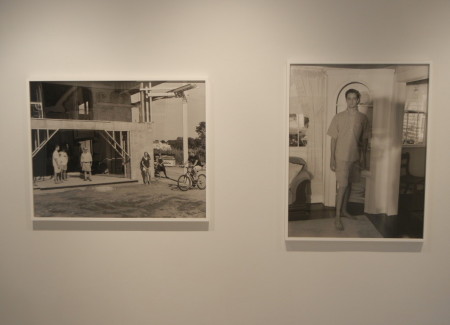JTF (just the facts): A total of 13 large scale black and white photographs, framed in white and unmatted, and hung against white walls in the divided gallery space. All of the works are gelatin silver prints, made between 2002 and 2013. Physical sizes range from 17×22 to 54×68, and the prints are available in editions of 5. A small catalog of the exhibit (designed by Chip Kidd) is available from the gallery. (Installation shots below.)
Comments/Context: At first glance, Tina Barney’s new show looks a little like a nostalgic throwback, or perhaps an unearthing of long lost 1970s negatives from earlier in her career. We find ourselves back in the comfortable company of the photographer’s family and friends and the summertime homes they inhabit, and the images are lushly executed in black and white, so these must be a blast from the past, right? Not so fast.
Barney’s silver prints are actually a recent body of work (made in the past decade), and feel like a testing exercise that an established photographer sets for herself to ensure she continues to push on her artistic boundaries. Having made a career out of photographing the movements and manners of her own life, she’s returned to that familiar subject matter to see what more it has to offer (especially as the generations age and the grandchildren multiply), but she’s done so within the stricter confines of the black and white palette – she’s consciously drained the color out of her work, and it’s forced her to rethink the balance of her compositions. In these pictures, we’re much less distracted by the traditions of matching pink, preppy Lily Pulitzer prints, or floral chintz, and that pared down aesthetic has put additional pressure on her ability to capture the gestures and subtle relationships that have long been the foundation of her work.
The good news is that Barney’s compositions remain deceptively sophisticated, mixing the candid with the staged with perceptive awareness. Many of her new images subtly tweak the scale of the setup to create quiet dissonance, her poses captured with painterly control. A peppy mother and daughter team pose in front of a distressingly perfect child’s play house, like oversized giants in the kingdom. Young girls play dress up, one toting a baby, the other holding a wigged mannequin head, the resemblance between the two creating an unsettling echo. And a family photo/mother’s lecture in front of the construction site of a new house is boldly interrupted by the encroaching black wall and sandy residue that threatens to suck them under.
Other images push our attention toward off kilter details, discordant furnishings, and cultural signifiers: an unexpected pair of crocs on an older woman, an upside down platter, a bronze statue (that looks exactly like the folds of skin on an older man nearby), a harvest of hot dogs, an awkward pose over a lawn chaise, and the shadow of Barney’s large format camera thrown across a dazed college kid stuffed into a corner. Every picture is pulled a fraction out of normal order, giving each casual scene a sense of being slightly but purposefully off balance.
The best images in this show take this smart compositional control several steps further. In The Magician, there are actually no less than four separate narratives – the kid’s party magician and the foreground girls being sprinkled with sparkly confetti, the other kids strewn on the ground watching with a mixture of mild interest, a hands-on-hips, camera toting, take charge mom in the background scouting the area near the jumpy castle, and an in-progress treehouse rescue of a stranded toddler. The Globe offers more quiet proof of Barney’s camera mastery – how often have we seen the central figure in a large scale portrait consciously blurred, placing the focal plane behind the main sitter? Her tactic creates sharpness in the mid range, where a young boy poses on the side (his mother’s shadow cast across him) and the edge of the opening to the next room (with its intricate wood molding) is captured in exacting detail; the view into the background (set apart by the crispness of the frame) could almost be a mirrored refection it’s so disorienting. And The Birthday Lunch seems like the kind of image that would normally have reveled in Barneyesque color – it’s easy to imagine the SpongeBob cake, the plastic tablecloth, and the tow headed kids as a symphony of bright yellow. But pushed into the realm of black and white, the alignment of the composition becomes more apparent – folded arms, balloon strings, vertical chair slats, an odd table divider, and a connect the dots row of heads; she’s made a staple of the chaos of summer into something altogether strange.
As usual, Barney has taken family rituals and turned them into fodder for thoughtful photographic exploration. But her return to black and white is a calculated risk, its constraints challenging her to refine and expand her compositional tactics. While her often ravishing use of color is momentarily missing, her new results are consistently well crafted, her command of the familial stage and its photographic representation no less confident or complete.
Collector’s POV: The prints in this show are priced at $7500, $9000, $18000, $20000, or $25000. Barney’s work has only been intermittently available in the secondary markets in recent years, with prices ranging from roughly $3000 to $42000.












